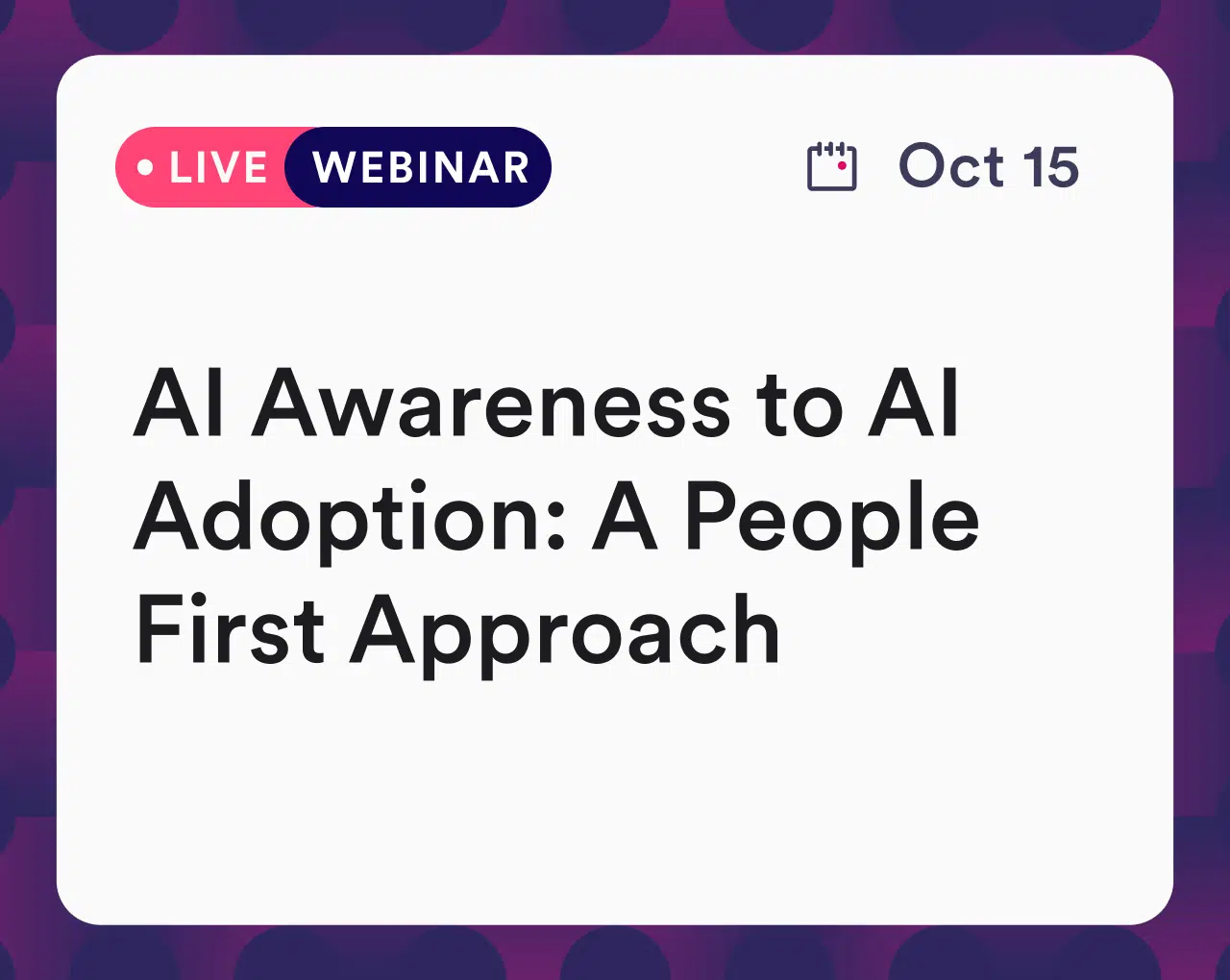Corporate learning hasn’t kept up with how people actually learn, or how they prefer to engage with different learning modalities.
It’s not that L&D teams aren’t trying — far from it. But under pressure to scale fast and serve everyone, many orgs default to a couple of go-to formats: some self-paced eLearning, maybe a one-off workshop.
The problem? That approach leaves way too much on the table. Passive content doesn’t drive active skills. One-time events don’t create lasting change. And generic programs? They disengage learners before they even begin.
Today’s workforce needs more than information — they need immersion, connection, and reinforcement. That’s where a multi-modal learning strategy comes in. The best L&D programs blend formats with intention: matching learning modalities to outcomes, reinforcing learning over time, and meeting people where they are.
In this post, we’ll break down different learning modalities, and how to combine them into a strategy that sticks — one that drives behavior change, supports measurable business outcomes, and helps your people grow.
Common Learning Modalities and Strategic Use Cases in L&D
To create lasting impact, learning needs the right delivery. All learning modalities bring different strengths to the table, depending on the goal, the audience, and the context. The real power lies in how you mix and match them to support the full learning journey. Here’s how they stack up.
In-Person Learning: High-Impact, High-Touch, High Price
Nothing beats the energy of people learning together in the same room. In-person experiences are especially effective for building hands-on skills, strengthening teams, and developing leaders. The format is immersive and memorable, but it’s also expensive and tough to scale. That makes it all the more important to use in-person learning intentionally, with clear reinforcement plans in place.
One-Day or Shorter Workshops
Great for team-building, leadership training, or practical skill-building, these sessions create immediate energy and focus. But without follow-up, that momentum fades fast. Reinforce key takeaways through coaching, discussion groups, or microlearning to turn short bursts into sustained growth.
Multi-Day Offsites and Retreats
These are best reserved for senior leaders, high-impact teams navigating transformation, or general team-building. While they aren’t typically suited for skill development, they excel at creating space for reflection, strategic thinking, and relationship-building. When people step away from their day-to-day responsibilities and connect in a different setting, it opens the door for deeper trust, alignment, and long-term visioning. Executive offsites, for example, are a powerful lever for resetting priorities, building motivation, and driving strategic clarity.
💬 When is in-person learning most valuable? Use it for moments that require deep connection, alignment, or transformation — like leadership offsites or high-stakes planning.
The downside? They’re costly, time-intensive, and disconnected from the flow of work. To maximize impact, be intentional about post-event reinforcement — whether through coaching, virtual check-ins, or peer mentoring — and define the strategic outcomes you want to support, like improved collaboration, leadership alignment, or cultural cohesion.
🔑 Key takeaways:
- Use for executive retreats, offsites, and complex team dynamics
- High-impact, but high-cost — use selectively
- Reinforce with coaching or peer groups to sustain impact
Virtual Instructor-Led Training: Scalable Human Connection, If You Do It Right
Virtual instructor-led training offers the human connection of a live experience with the flexibility and reach of digital. It’s ideal for leadership development, soft skills, and global teams, but only when designed with intention. Engagement depends on pacing, facilitation, and interactivity. And just like in-person formats, vILT needs thoughtful reinforcement to drive long-term impact.
Live Courses and Masterclasses
When delivered well, live courses and masterclasses can be dynamic and effective. Learners stay engaged through tools like breakout rooms, live polling, role-play, and chat-based reflection. To keep the momentum going, follow up with bite-sized microlearning or peer discussions that encourage learners to apply what they’ve learned.
Team Development in Virtual Settings
For hybrid and remote teams, virtual instructor-led training can strengthen collaboration and connection. But it’s not as simple as dropping a team into a Zoom room. Strong facilitation and structured exercises are critical. Real-world challenges, shared goals, and follow-up coaching help teams internalize and apply new ways of working together.
💬 How does virtual learning compare to in-person for team development? With great facilitation and structure, virtual can create powerful connection — but it needs deliberate design to match in-person impact.
🔑 Key takeaways:
- Works best with strong facilitation and interactivity
- Ideal for distributed or global teams
- Needs reinforcement through coaching or microlearning
Personality Assessments: Insightful, But Only If You Act On Them
Tools like DiSC, MBTI, and StrengthsFinder can be powerful catalysts for self-awareness and team growth. When used well, they give learners a language to describe how they communicate, make decisions, respond to stress, and collaborate with others. That kind of insight can shift how people show up, especially in leadership development and team settings.
But here’s the catch: a personality assessment is just a starting point. Too often, organizations run a session, hand out the results, and move on. Without follow-up, the insight fades and nothing really changes.
💬 Why do assessments fall flat without follow-up? Without ongoing reflection or coaching, insights fade quickly — the real value lies in sustained application.
To make the most of these tools, they need to be integrated into something bigger, like a coaching engagement, a team workshop, or a broader development program. When assessments are used as a foundation for deeper conversations and intentional growth, they can unlock a whole new level of effectiveness and collaboration.
🔑 Key Takeaways:
- Use assessments as a launchpad, not a standalone event
- Integrate into coaching or team workshops
- Sustain momentum with structured follow-up
Coaching and Mentorship: Personalized, Impactful, and Built for Growth
Few learning modalities are as powerful (or as personal) as coaching and mentorship. They’re uniquely suited for helping people grow as leaders, navigate change, and apply learning in the real world. Coaching supports deep transformation, creates accountability, and offers personalized growth paths — which makes it especially valuable for retaining and advancing high-potential talent.
💬 How do you scale coaching without losing personalization? Pair 1:1 coaching with group formats and AI support. Structure and alignment are key.
1. 1:1 Coaching
Whether it’s executive coaching or leadership development, one-on-one coaching creates space for real transformation. It’s high-touch, highly tailored, and ideal for behavior change that sticks. The tradeoff, of course, is cost and scale — coaching isn’t cheap, and it requires experienced practitioners. That’s why many organizations reserve it for key talent or leadership roles. To increase the ROI, smart programs align coaching with defined competencies and reinforce learning between sessions with nudges, peer discussions, or light-touch follow-ups.
2. Group Coaching and Peer Mentoring
If 1:1 coaching is a mirror, group coaching is a conversation. It brings people together to share experiences, tackle challenges, and learn from one another in a psychologically safe environment. Cohorts promote reflection, social learning, and a strong sense of shared accountability — key drivers of sustained behavior change. This format works especially well for developing leadership pipelines, supporting new managers, or building communities of practice, but it’s not self-sustaining. Groups need structure and facilitation to stay focused and valuable. Create prompts, themes, or shared goals to keep the learning on track and the accountability strong.
3. AI Coaching
AI-driven coaching is a newer player, but a promising one. It offers personalized feedback at scale, surfacing insights in real time and nudging learners to apply what they’ve learned. It’s not a replacement for human coaching — context and empathy still matter — but it can be a great reinforcement tool. When paired with human-led development, AI coaching can help extend the impact, reduce reliance on costly resources, and support continuous growth between live touchpoints.
🔑 Key Takeaways:
- Use 1:1 coaching for high-potential or executive roles
- Group formats promote shared accountability and community
- AI coaching is a scalable way to reinforce and personalize learning
Experiential and Social Learning: The Power of Community
People don’t just learn from content — they learn from each other. Social and experiential learning taps into something deeper: shared experience, real-time feedback, and the kind of insight that only comes from conversation. When learning is embedded in community, it becomes more relevant, more sticky, and a lot more human.
💬 How does social learning boost retention? People remember what they discuss and apply. Peer connection brings relevance and accountability.
1. Discussion Groups and Networking Forums
Whether it’s a leadership circle, a cross-functional cohort, or an informal Slack channel, peer learning creates space for reflection, vulnerability, and idea-sharing. It helps people connect the dots between theory and practice, especially when they’re learning from others who’ve been there. But these groups don’t run themselves. Without structure, energy fizzles fast. Guided prompts, light facilitation, or a rotating “host” can go a long way toward keeping things focused, inclusive, and productive.
2. Mentorship Programs
Formal and informal mentorship programs are another powerful way to foster connection, learning, and growth. By pairing individuals with more experienced colleagues, mentorship creates space for personal development, role modeling, and candid conversations about challenges and goals. These relationships support culture-building, reinforce lessons from other learning modalities, and help emerging talent navigate the complexity of growing into new roles. To make mentorship programs effective, it’s important to provide structure: set expectations, offer guidance for both mentors and mentees, and create regular touchpoints.
3. External Programs (Courses, Conferences, Certifications)
Bringing in outside learning — through universities, industry conferences, or credentialed programs — can inject fresh thinking and expand skill sets. These experiences offer credibility, exposure to cutting-edge ideas, and the chance to learn from experts in the field. But they’re often disconnected from day-to-day work. To close that gap, leaders should create clear connections between external learning and internal goals. That could mean a debrief with a team, coaching conversations tied to program takeaways, or even a capstone project that brings new knowledge back into the business.
🔑 Key Takeaways:
- Social learning promotes relevance, reflection, and retention
- Structure is essential to keep groups focused and impactful
- Mentorship and external learning benefit from intentional integration
Digital and On-Demand Learning: Flexible and Scalable, But Not Enough On Its Own
Digital learning is the workhorse of most L&D strategies — for good reason. It’s flexible, scalable, and available on demand. But while digital tools are great at delivering information, they rarely drive transformation on their own. Without context, application, or human connection, the learning often stays surface-level. That’s why digital learning modalities are most powerful when used as part of a broader, blended strategy.
💬 Can digital tools replace human-led learning? Not entirely. Use them to augment, not replace, deeper experiences like coaching or peer learning.
Self-Paced eLearning and Certifications
Online courses are ideal for foundational knowledge, compliance training, or technical skills that require repetition and self-pacing. They’re efficient, consistent, and accessible anytime. The downside? Engagement is often low, and learners may struggle to apply what they’ve learned in real-world scenarios. To close that gap, combine self-paced content with live coaching, peer mentoring, or discussion groups. Bringing people together to reflect and apply the material makes all the difference.
Microlearning and AI Nudges
Short, focused bursts of content, delivered right when learners need them, can be incredibly effective for reinforcement. Microlearning and AI nudges help embed new habits, keep knowledge fresh, and support continuous growth without overwhelming people. They’re perfect for just-in-time reminders or post-training reinforcement. But they’re not a complete solution. To maximize impact, use microlearning to extend structured programs and drive retention — not to replace deeper learning experiences.
🔑 Key Takeaways:
- Best for foundational or just-in-time learning
- Reinforce with coaching or group discussion for real-world impact
- Combine microlearning with deeper programs for long-term retention
Empowering People Managers to Reinforce Learning
💬 What’s the fastest way to scale learning impact across teams? Empower your people managers. With the right tools, they become daily reinforcers of culture and capability.
L&D doesn’t happen in a vacuum — and it shouldn’t rest solely on the shoulders of a central team. One of the most powerful ways to scale learning impact is by enabling people managers to become multipliers. When managers are equipped to reinforce learning — through ongoing coaching conversations, team reflections, or modeling desired behaviors — they extend the shelf life of every learning experience.
Give managers tools and prompts to help reinforce learning within their teams. That might mean sharing discussion questions post-workshop, guiding team debriefs after training, or nudging habit-building in one-on-ones. With the right enablement, people managers become key drivers of culture, behavior change, and applied learning, even when L&D teams are lean.
What a Multi-Modal Learning Strategy Can Look Like in Action
It’s one thing to talk about blending learning modalities — it’s another to see what that actually looks like across a real L&D program. Below are two examples of how companies are combining live classes, cohort-based experiences, and learner-led exploration to create scalable, high-impact learning journeys for employees at every level.
A Layered Approach for All Employees and Senior Leaders
This program blends a variety of learning modalities to engage employees at all levels. All employees participate in live virtual membership classes and on-demand digital content, while senior leaders engage in private cohort-based programs, executive peer discussions, and in-person offsites. The experience is supported by continuous microlearning, habit nudges, and manager enablement to drive application.
Key touchpoints include:
- Live virtual classes and masterclasses on leadership, communication, and high-performance habits
- In-person executive offsites for reflection, alignment, and strategic planning
- Peer-based learning through coaching circles, discussion groups, and capstone presentations
- Asynchronous tools like microlearning and AI nudges to reinforce learning over time
This multi-modal approach supports strategic alignment at the leadership level, continuous growth for all employees, and measurable outcomes like stronger leadership pipelines and improved engagement.
Cohort-Based Development for Managers at Every Stage
This program develops leadership capabilities across manager levels through a consistent, yet flexible, multi-modal approach. First-time managers start with core skills through live virtual sessions and asynchronous content, while mid-level and senior leaders progress into more advanced topics with additional coaching and in-person workshops.
Each quarter blends:
- Live virtual learning focused on essential leadership behaviors and high-impact communication
- Peer-based development through manager roundtables and executive mentorship
- Self-paced learning and habit reinforcement via nudges and digital content
- Strategic in-person sessions like regional workshops or senior offsites for deeper connection
Together, these touchpoints create a cohesive learning journey that’s scalable, targeted, and grounded in real-world leadership application. In fact, McKinsey found that the most effective leadership development programs integrate multiple learning formats, rather than relying on a single method.
The Future of Learning is Hybrid, Personalized, and Continuous
There’s no one-size-fits-all anymore, and that’s a good thing. The most effective L&D strategies blend multiple learning modalities to meet learners where they are, keep them engaged, and help them apply what they’ve learned in the real world. When you combine in-person experiences, virtual sessions, coaching, and digital tools with intention, you create something much more powerful than any one format alone.
And when you connect those learning modalities to measurable outcomes — like increased retention, stronger leaders, improved team health, and visible behavior change — your L&D strategy becomes a true driver of business impact.
Organizations that embrace a multi-modal approach aren’t just ticking the training box. They’re building agile, connected, and future-ready teams.
If you’re rethinking your current L&D strategy, now’s the time to ask: Is it dynamic? Is it continuous? And most importantly, is it driving the outcomes that matter?
At Hone, we specialize in delivering high-impact learning experiences that blend live training, coaching, and peer-based learning to create real behavior change. Whether you’re building stronger leaders, upskilling teams, or reinforcing growth with AI-powered coaching, we’re here to help you bring it all together.
TL;DR: What Matters Most When Leveraging Multiple Learning Modalities
- No single format drives transformation — blend learning modalities intentionally
- Reinforcement is key: learning must extend beyond the moment
- Empower managers and peers as learning multipliers
- Match formats to strategic goals — not just convenience The future is hybrid, human, and always evolving












